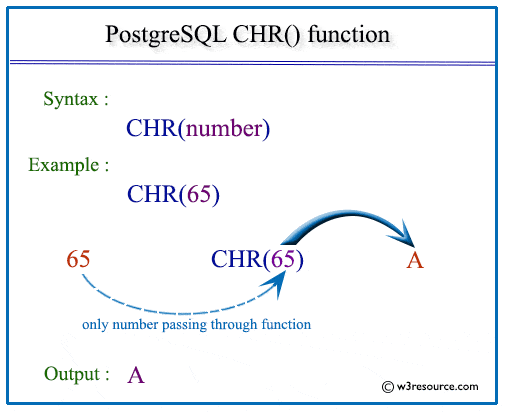PostgreSQL CHR() function
CHR() function
The PostgreSQL chr function is used to return the corresponding character against the given code within the argument. This function is useful for converting numeric ASCII codes back to their character representations, which can be helpful in various text processing and data manipulation tasks.
Uses of CHR() Function
- Character Conversion: Convert numeric ASCII codes to their corresponding characters.
- Data Formatting: Generate special characters based on their ASCII codes for formatting purposes.
- Custom Character Generation: Create characters dynamically in queries or applications.
- String Construction: Build strings with specific characters based on their ASCII values.
- Text Data Manipulation: Enhance text processing by converting codes to characters as needed.
Syntax:
chr(number)
PostgreSQL Version: 9.3
Visual Presentation of PostgreSQL CHR() function
Example: PostgreSQL CHR() function:
In the example below, the chr function returns the character against the corresponding code.
SQL Code:
SELECT chr(90) AS "Character of CODE(90)";
Output:
Character of CODE(90) ----------------------- Z (1 row)
Example of PostgreSQL CHR() function using column:
Sample Table: employees
Here in the example, we want to make a query without using LEFT(), SUBSTRING() function. We want to find those employees who start their first_name with the letter 'A'. Here we have displayed three columns i.e. empoloyee_id, first_name and last_name.
SQL Code:
SELECT employee_id,first_name,last_name
FROM employees
WHERE chr(ascii(first_name))='A';
Output:
employee_id | first_name | last_name
-------------+------------+-----------
103 | Alexander | Hunold
115 | Alexander | Khoo
121 | Adam | Fripp
147 | Alberto | Errazuriz
158 | Allan | McEwen
167 | Amit | Banda
175 | Alyssa | Hutton
185 | Alexis | Bull
187 | Anthony | Cabrio
196 | Alana | Walsh
(10 rows)
Previous: BTRIM function
Next: CONCAT function

